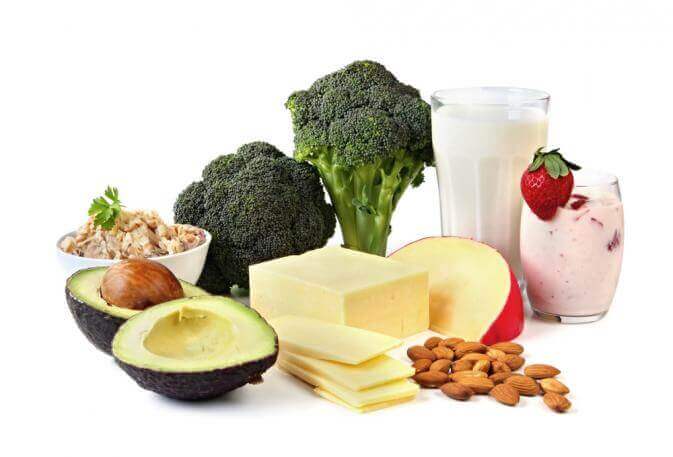The Scary Truth About Osteoporosis

Bone health may not be something you think about very often, especially if you're a young woman, but maybe it should be. Osteoporosis affects up to 200 million women worldwide. About half of women over age 50 will break a bone because of osteoporosis. Of the 10 million women with osteoporosis in America, a whopping 80% are women. It may seem like it doesn't matter while you're young, but
the time to prevent osteoporosis is now.
The Facts
Let's talk about something called peak bone mass.
Peak bone mass is the greatest amount of bone tissue that a person has during their life. For most people, peak bone mass is reached by the time they reach the age of 30. However, ninety percent of calcium is deposited by the age of eighteen to twenty years. This means that twenty-somethings need to work extra hard to add to or maintain that peak bone mass, because here's some bad news: after a certain age, bone mass starts to decrease (see graph).

As you can see, there is a gradual loss until menopause, where there is an
acceleration of bone loss. A measly
ten percent loss in bone mass can double the risk of vertebral fractures. In women over the age of 45, osteoporosis accounts for more time spent in the hospital than diabetes, heart attack, and even breast cancer. Women need to be diligent about calcium intake and store up bone mass now so that later they won't be left with brittle bones.
High peak bone density early in life reduces the risk of osteoporosis later.
Factors That Affect Peak Bone Mass
 1. Gender
1. Gender
Obviously gender plays a role in the risk for bone loss as men don't go through menopause, so they don't have that drastic loss in a relatively short period of time. Additionally, after puberty men tend to acquire greater bone mass than women.
2. Race
Caucasian females are at a higher risk than African American females. The difference in bone density is even seen during childhood and adolescence.
3. Hormonal factors
Women who had their first menstrual cycle at an early age and those who use oral contraceptives that contain estrogen often have higher bone mineral density than women whose periods started late or who lost it because of excessive exercise or extremely low weight.
4. Nutrition
Calcium is essential for bone health. Sadly, less than ten percent of girls age 9 to 17 are getting the calcium they need each day.
5. Physical activity
Regular exercise may play a part in achieving greater peak bone mass. Women can help prevent bone loss with regular exercise, especially weight-bearing exercise (see below).
6. Lifestyle Behaviors
Smoking has been linked to low bone density in adolescents and when those smokers grow up they are at further risk for bone loss and fracture.
Things You Can Do Now
Now that you've been intimidated by scary facts and charts, here are things that you can do now while you're young to prevent osteoporosis:
1. Take in Calcium and Vitamin D

This first one is obvious (hopefully).
Calcium and vitamin D are both essential to healthy bones. Calcium builds the bones, but vitamin D is what helps the body absorb the calcium. Women should aim for
at least 1,000 mg of calcium daily, and 1,200 mg over the age of 50. Here's the catch: the body can only absorb about 500 mg at a time, so you need to spread your calcium intake throughout the day, whether its in food form or pill form. Women should also aim for about
600 IU (international units) each day of vitamin D.

Good sources of calcium include milk, cottage cheese, yogurt, canned salmon, calcium-fortified orange juice, spinach, turnip greens, collard greens and broccoli. You can go
here to see a great list of calcium-rich foods and how much calcium is in each of them. If you feel like you just can't eat all of those collard greens, or maybe have a diet absent of dairy, calcium supplements are available in two forms: calcium carbonate (take with food) and calcium citrate (okay without food). Be sure whatever form you decide on to take twice a day in order to absorb enough calcium.
As for Vitamin D, you can stimulate production by being in the sun, but if you aren't outside all day and need that extra dose, some other good sources are: flesh of fatty fish, fortified milk, fortified orange juice, supplements, egg yolks, fortified cereal, and cod liver oil.
2. Exercise

Regular exercise has a vast number of benefits. One of those is improved bone health. The best kind of exercise for osteoporosis prevention is
weight-bearing exercise and strength training. This includes a combination of walking, jogging, stair climbing, lifting weights, yoga, or body-weight exercises (push-ups, planks, wall-sits, sit-ups, etc). These exercises help keep bones strong by causing the muscles and tendons to pull on the bones, which in turn stimulates bone cells to produce more bones.
3. Cut Down on the Soda

Some studies have shown that the extra phosphorous in carbonated drinks may contribute to bone loss by binding with calcium and preventing it from being deposited in the body.
4. Make Sure Your Weight Loss Isn't Over the Top

When women lose too much weight they are at risk for losing their period. This can lead to major bone loss and can add to the risk of osteoporosis. What's worse is that in cases of prolonged low weight, as in anorexia nervosa, the
bone loss is often irreversible.
Sources:
http://www.iofbonehealth.org/facts-statistics
http://nof.org/articles/235
http://www.tipsfromtown.com/wp-content/uploads/2013/03/shutterstock_27454780-e1363832870825.jpg
http://classes.kumc.edu/coa/images/Reynolds/bone-mass-graph.gif
http://www.aoafamily.com/client_files/image/news-pics/2012-06/osteoporosis.jpg
http://www.webmd.com/osteoporosis/guide/peak-bone-mass?page=2
http://www.webmd.com/osteoporosis/living-with-osteoporosis-7/lifestyle-tips
http://www.webmd.com/osteoporosis/features/are-you-getting-enough-vitamin-d-calcium
http://nof.org/articles/886
http://www.factfiend.com/wp-content/uploads/2014/09/got-milk-superman.jpeg
http://www.health.com/health/gallery/0,,20504538_4,00.html
http://www.quickanddirtytips.com/sites/default/files/styles/insert_large/public/images/4360/foodsourcesofcalcium.jpg?itok=c7uhh3cW
http://weighttraining.about.com/od/weighttrainingforhealth/a/osteo.htm
http://www.webmd.com/osteoporosis/guide/osteoporosis-prevention?page=2
http://feast-ed.org/Osteoporosisandeatingdisorders.aspx







































